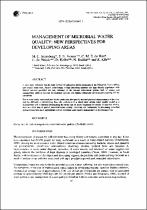JavaScript is disabled for your browser. Some features of this site may not work without it.
- ResearchSpace
- →
- Research Publications/Outputs
- →
- Journal Articles
- →
- View Item
| dc.contributor.author |
Steynberg, MC

|
en_US |
| dc.contributor.author |
Venter, SN

|
en_US |
| dc.contributor.author |
De Wet, CME

|
en_US |
| dc.contributor.author |
Du Plessis, G

|
en_US |
| dc.contributor.author |
Holhs, D

|
en_US |
| dc.contributor.author |
Rodda, N

|
en_US |
| dc.contributor.author |
Kfir, R

|
en_US |
| dc.date.accessioned | 2007-03-14T07:20:15Z | en_US |
| dc.date.accessioned | 2007-06-07T10:03:23Z | |
| dc.date.available | 2007-03-14T07:20:15Z | en_US |
| dc.date.available | 2007-06-07T10:03:23Z | |
| dc.date.issued | 1995 | en_US |
| dc.identifier.citation | Steynberg, MC, et al. 1995. Management of microbial water quality: New perspectives for developing areas. Water Science and Technology, vol. 32, May, pp 183-191 | en_US |
| dc.identifier.issn | 0273-1223 | en_US |
| dc.identifier.uri | http://hdl.handle.net/10204/1901 | en_US |
| dc.identifier.uri | http://hdl.handle.net/10204/1901 | |
| dc.description.abstract | A case study indicated that the high number of pathogenic micro-organisms in the Rietspruit South Africa, can impact water uses. Factors contributing to high microbial numbers are high density population with limited services provided per site, sabotage of the sewage reticulation system, lack of money and management skills to provide the essential services and limited integrated development planning for the catchment. Due to non-steady state conditions in the catchment, the specific use and physical characteristics of the river and the difficulty in determining flow, the usefulness of a steady-state stream water quality model as a management tool is limited. Determining the decay rate of micro-organisms by means of chamber studies, may be a first step to predict microbial water quality. Involving the community in preventing microbial pollution may be a more appropriate tool for microbial water quality management in developing areas. | en_US |
| dc.format.extent | 412917 bytes | en_US |
| dc.format.mimetype | application/pdf | en_US |
| dc.language.iso | en | en_US |
| dc.publisher | Pergamon-Elsevier Science Ltd | en_US |
| dc.rights | Copyright: 1995 Pergamon-Elsevier Science Ltd | en_US |
| dc.subject | Decay rate | en_US |
| dc.subject | E.coli | en_US |
| dc.subject | Management | en_US |
| dc.subject | Microbial water quality | en_US |
| dc.subject | QUAL2E | en_US |
| dc.subject | Rivers | en_US |
| dc.title | Management of microbial water quality: New perspectives for developing areas | en_US |
| dc.type | Article | en_US |
| dc.identifier.apacitation | Steynberg, M., Venter, S., De Wet, C., Du Plessis, G., Holhs, D., Rodda, N., & Kfir, R. (1995). Management of microbial water quality: New perspectives for developing areas. http://hdl.handle.net/10204/1901 | en_ZA |
| dc.identifier.chicagocitation | Steynberg, MC, SN Venter, CME De Wet, G Du Plessis, D Holhs, N Rodda, and R Kfir "Management of microbial water quality: New perspectives for developing areas." (1995) http://hdl.handle.net/10204/1901 | en_ZA |
| dc.identifier.vancouvercitation | Steynberg M, Venter S, De Wet C, Du Plessis G, Holhs D, Rodda N, et al. Management of microbial water quality: New perspectives for developing areas. 1995; http://hdl.handle.net/10204/1901. | en_ZA |
| dc.identifier.ris | TY - Article AU - Steynberg, MC AU - Venter, SN AU - De Wet, CME AU - Du Plessis, G AU - Holhs, D AU - Rodda, N AU - Kfir, R AB - A case study indicated that the high number of pathogenic micro-organisms in the Rietspruit South Africa, can impact water uses. Factors contributing to high microbial numbers are high density population with limited services provided per site, sabotage of the sewage reticulation system, lack of money and management skills to provide the essential services and limited integrated development planning for the catchment. Due to non-steady state conditions in the catchment, the specific use and physical characteristics of the river and the difficulty in determining flow, the usefulness of a steady-state stream water quality model as a management tool is limited. Determining the decay rate of micro-organisms by means of chamber studies, may be a first step to predict microbial water quality. Involving the community in preventing microbial pollution may be a more appropriate tool for microbial water quality management in developing areas. DA - 1995 DB - ResearchSpace DP - CSIR KW - Decay rate KW - E.coli KW - Management KW - Microbial water quality KW - QUAL2E KW - Rivers LK - https://researchspace.csir.co.za PY - 1995 SM - 0273-1223 T1 - Management of microbial water quality: New perspectives for developing areas TI - Management of microbial water quality: New perspectives for developing areas UR - http://hdl.handle.net/10204/1901 ER - | en_ZA |






